Abstract
Band 3, the red blood cell (RBC) anion channel protein, is the target autoantigen for the pathogenic RBC autoantibodies and T-helper (Th) cells in New Zealand Black (NZB) mice with autoimmune haemolytic anaemia (AIHA). To determine the subpopulation of these Th cells, they were stimulated with Band 3 and the profile of the cytokines elaborated by the responding cells was measured. NZB T cells stimulated with Band 3 produced high levels of the Th1 cytokine, interferon-gamma (IFN-gamma), but little or no interleukin-4 (IL-4), IL-5 or IL-10. Similar patterns were produced by NZB T cells responding to a spectrin preparation from the RBC membrane skeleton, or to mycobacterial heat-shock protein (hsp) 65 following immunization of mice with hsp 65 in incomplete adjuvant. By contrast, T cells from CBA mice similarly immunized with hsp 65 produced high levels of IL-4 and IL-5 in response to hsp 65. Examination of the isotype of the RBC-bound immunoglobulins in NZB mice revealed that immunoglobulin G2a (IgG2a) autoantibodies were the first to be detected in most mice and that later in the disease, IgG3 autoantibodies were often prominent. It is concluded that, contrary to expectation, the development of RBC autoantibodies in NZB mice is associated with Th1 cytokine-dominated responses.
Full text
PDF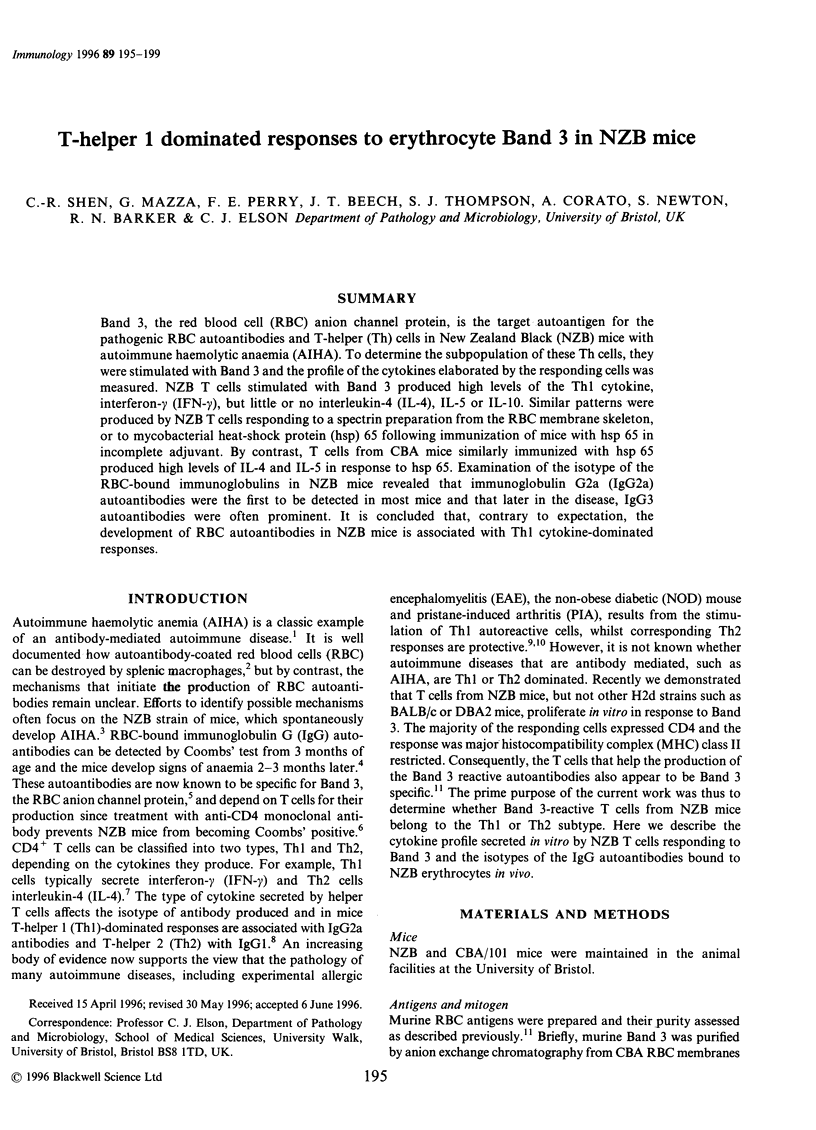
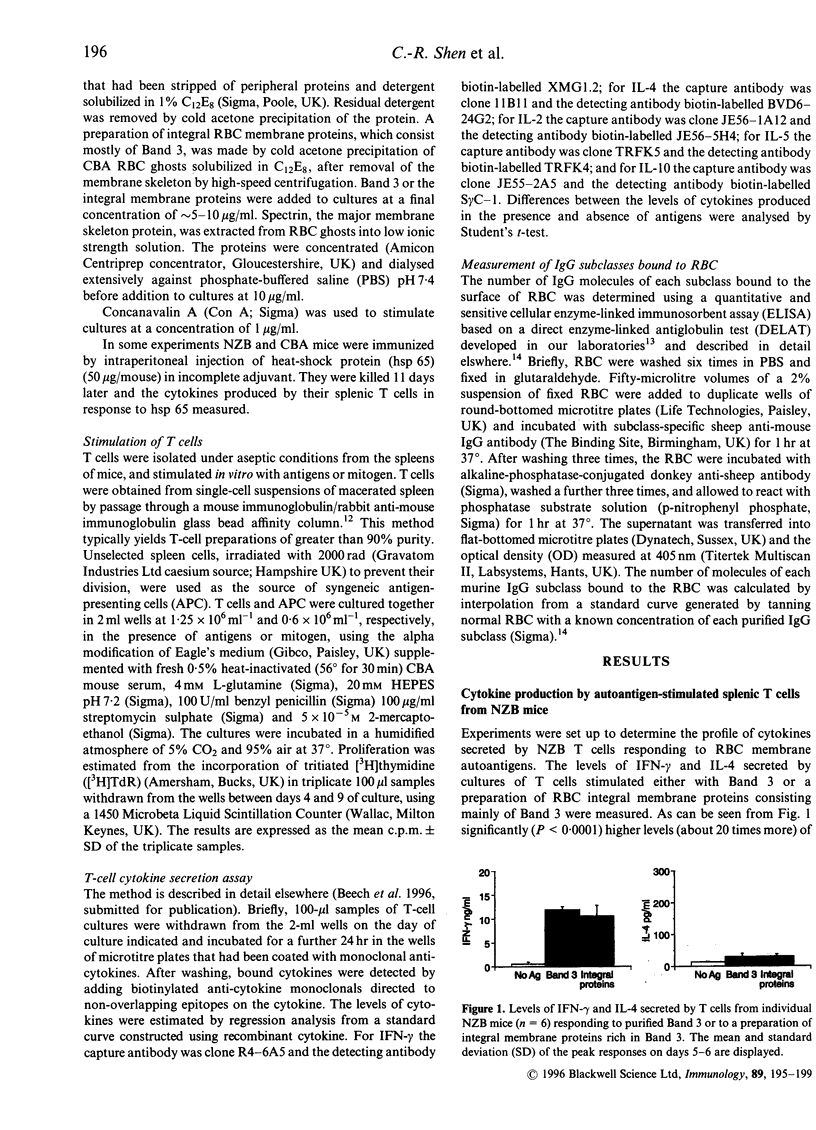
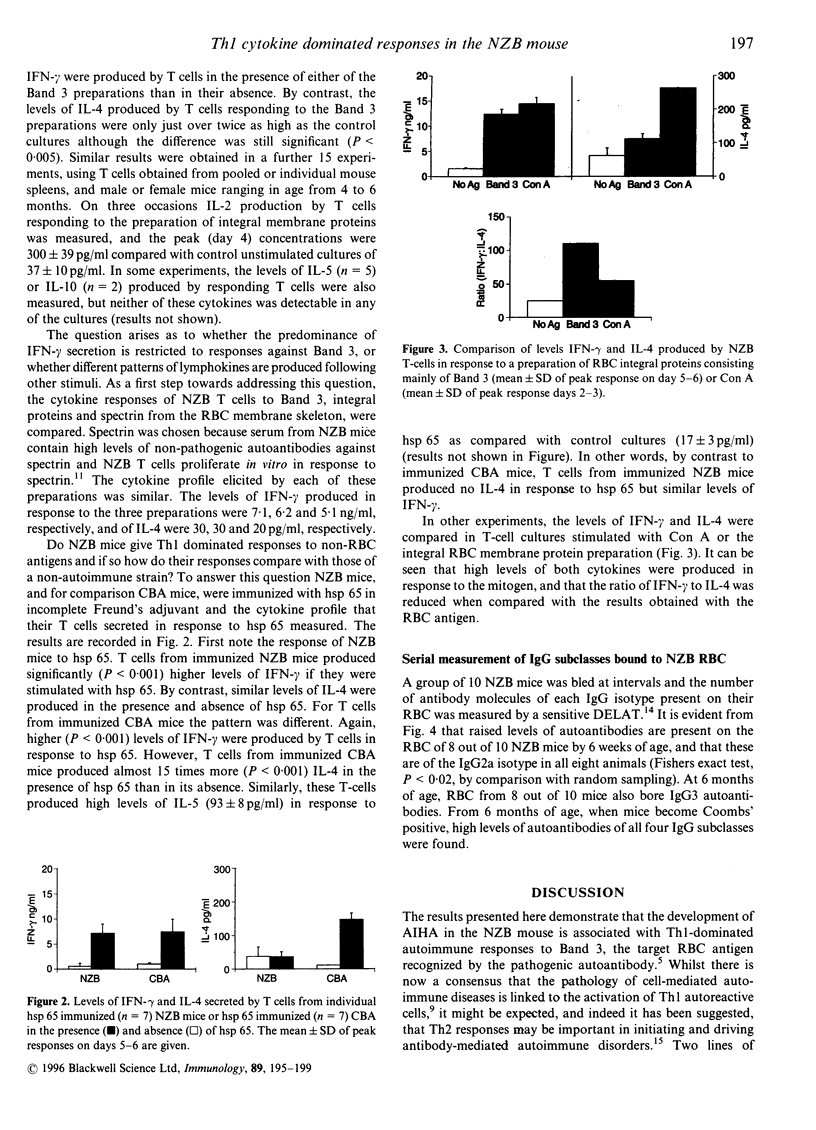
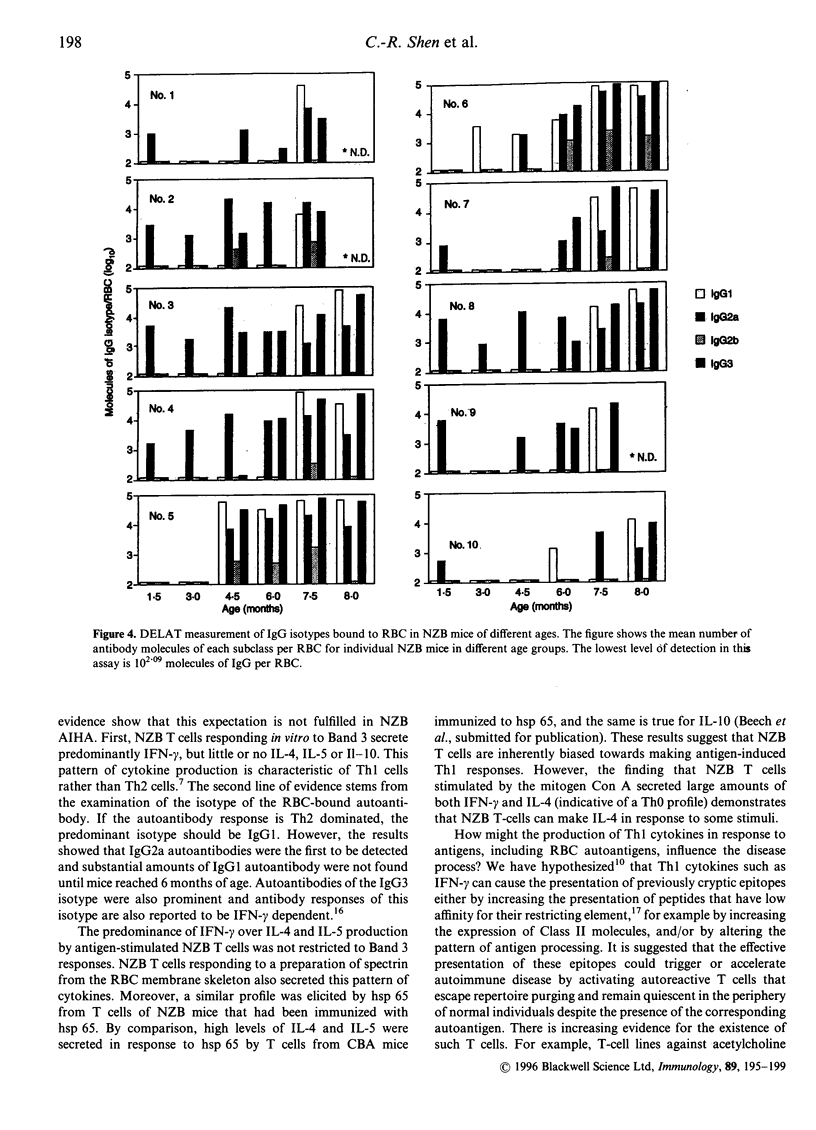
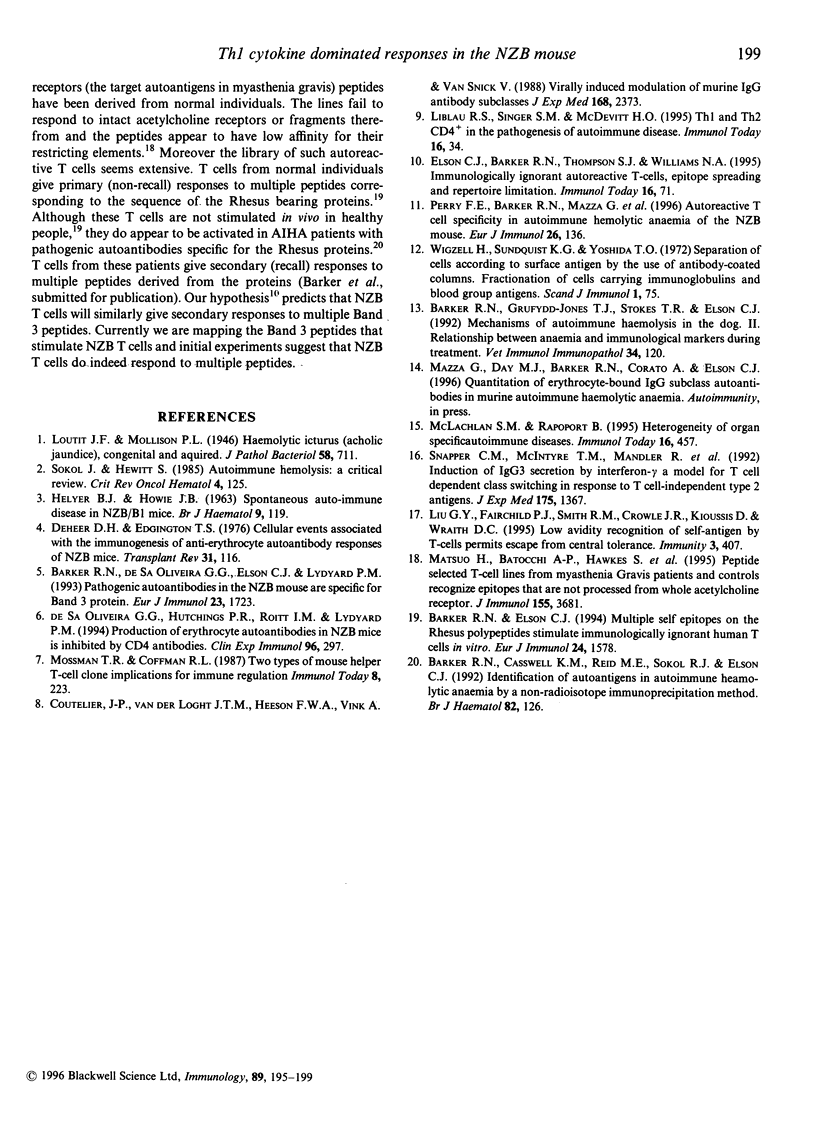
Images in this article
Selected References
These references are in PubMed. This may not be the complete list of references from this article.
- Barker R. N., Casswell K. M., Reid M. E., Sokol R. J., Elson C. J. Identification of autoantigens in autoimmune haemolytic anaemia by a non-radioisotope immunoprecipitation method. Br J Haematol. 1992 Sep;82(1):126–132. doi: 10.1111/j.1365-2141.1992.tb04604.x. [DOI] [PubMed] [Google Scholar]
- Barker R. N., Elson C. J. Multiple self epitopes on the Rhesus polypeptides stimulate immunologically ignorant human T cells in vitro. Eur J Immunol. 1994 Jul;24(7):1578–1582. doi: 10.1002/eji.1830240719. [DOI] [PubMed] [Google Scholar]
- Barker R. N., de Sá Oliveira G. G., Elson C. J., Lydyard P. M. Pathogenic autoantibodies in the NZB mouse are specific for erythrocyte band 3 protein. Eur J Immunol. 1993 Jul;23(7):1723–1726. doi: 10.1002/eji.1830230750. [DOI] [PubMed] [Google Scholar]
- Coutelier J. P., van der Logt J. T., Heessen F. W., Vink A., van Snick J. Virally induced modulation of murine IgG antibody subclasses. J Exp Med. 1988 Dec 1;168(6):2373–2378. doi: 10.1084/jem.168.6.2373. [DOI] [PMC free article] [PubMed] [Google Scholar]
- Deheer D. H., Edginton T. S. Cellular events associated with the immunogenesis of anti-erythrocyte autoantibody responses of NZB mice. Transplant Rev. 1976;31:116–155. doi: 10.1111/j.1600-065x.1976.tb01453.x. [DOI] [PubMed] [Google Scholar]
- Elson C. J., Barker R. N., Thompson S. J., Williams N. A. Immunologically ignorant autoreactive T cells, epitope spreading and repertoire limitation. Immunol Today. 1995 Feb;16(2):71–76. doi: 10.1016/0167-5699(95)80091-3. [DOI] [PubMed] [Google Scholar]
- HELYER B. J., HOWIE J. B. Spontaneous auto-immune disease in NZB/BL mice. Br J Haematol. 1963 Apr;9:119–131. doi: 10.1111/j.1365-2141.1963.tb05450.x. [DOI] [PubMed] [Google Scholar]
- Liu G. Y., Fairchild P. J., Smith R. M., Prowle J. R., Kioussis D., Wraith D. C. Low avidity recognition of self-antigen by T cells permits escape from central tolerance. Immunity. 1995 Oct;3(4):407–415. doi: 10.1016/1074-7613(95)90170-1. [DOI] [PubMed] [Google Scholar]
- McLachlan S. M., Rapoport B. Heterogeneity of organ-specific autoimmune diseases. Immunol Today. 1995 Sep;16(9):457–458. doi: 10.1016/0167-5699(95)80024-7. [DOI] [PubMed] [Google Scholar]
- Oliveira G. G., Hutchings P. R., Roitt I. M., Lydyard P. M. Production of erythrocyte autoantibodies in NZB mice is inhibited by CD4 antibodies. Clin Exp Immunol. 1994 May;96(2):297–302. doi: 10.1111/j.1365-2249.1994.tb06557.x. [DOI] [PMC free article] [PubMed] [Google Scholar]
- Perry F. E., Barker R. N., Mazza G., Day M. J., Wells A. D., Shen C. R., Schofield A. E., Elson C. J. Autoreactive T cell specificity in autoimmune hemolytic anemia of the NZB mouse. Eur J Immunol. 1996 Jan;26(1):136–141. doi: 10.1002/eji.1830260121. [DOI] [PubMed] [Google Scholar]
- Snapper C. M., McIntyre T. M., Mandler R., Pecanha L. M., Finkelman F. D., Lees A., Mond J. J. Induction of IgG3 secretion by interferon gamma: a model for T cell-independent class switching in response to T cell-independent type 2 antigens. J Exp Med. 1992 May 1;175(5):1367–1371. doi: 10.1084/jem.175.5.1367. [DOI] [PMC free article] [PubMed] [Google Scholar]
- Sokol R. J., Hewitt S. Autoimmune hemolysis: a critical review. Crit Rev Oncol Hematol. 1985;4(2):125–154. doi: 10.1016/s1040-8428(85)80013-5. [DOI] [PubMed] [Google Scholar]
- Wigzell H., Sundqvist K. G., Yoshida T. O. Separation of cells according to surface antigens by the use of antibody-coated columns. Fractionation of cells carrying immunoglobulins and blood group antigen. Scand J Immunol. 1972;1(1):75–87. doi: 10.1111/j.1365-3083.1972.tb03737.x. [DOI] [PubMed] [Google Scholar]




